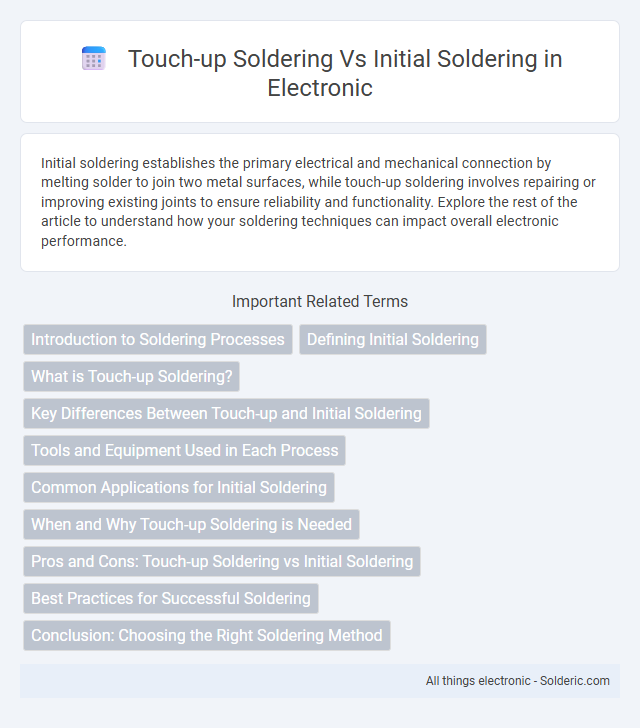Initial soldering establishes the primary electrical and mechanical connection by melting solder to join two metal surfaces, while touch-up soldering involves repairing or improving existing joints to ensure reliability and functionality. Explore the rest of the article to understand how your soldering techniques can impact overall electronic performance.
Comparison Table
| Aspect | Touch-up Soldering | Initial Soldering |
|---|---|---|
| Purpose | Repair or improve existing solder joints | Create new solder joints during assembly |
| Application Stage | Post-production or maintenance | During initial manufacturing or assembly |
| Process Complexity | Less complex, targeted application | More comprehensive, full component attachment |
| Equipment | Soldering iron, fine tips, and flux | Soldering stations, wave or reflow soldering machines |
| Typical Defects Addressed | Cold joints, cracks, insufficient solder | Establishing reliable electrical connections |
| Time Required | Short, focused repair time | Longer, complete assembly process |
| Skill Level | High precision and care needed for minimal damage | Standard soldering skills for consistent quality |
| Outcome | Restores or improves solder joint quality | Ensures initial strong and conductive joints |
Introduction to Soldering Processes
Initial soldering establishes the foundational electrical and mechanical connections on a printed circuit board (PCB) using precise temperature control and flux to ensure strong, reliable joints. Touch-up soldering involves correcting or reinforcing existing joints to address defects such as cold joints, insufficient solder, or lifted pads, often performed after initial assembly and inspection. Both processes rely on appropriate solder alloys, soldering irons or reflow ovens, and operator skill to maintain circuit integrity and functionality.
Defining Initial Soldering
Initial soldering establishes the primary electrical and mechanical connection between components and the printed circuit board (PCB) during assembly. It involves applying solder to create strong, reliable joints that ensure circuit functionality and durability. Your manufacturing process relies on precise initial soldering to maintain product quality and performance before any touch-up soldering is performed.
What is Touch-up Soldering?
Touch-up soldering involves repairing or refining existing solder joints to fix defects such as cold joints, solder bridges, or insufficient wetting, ensuring reliable electrical connections. Unlike initial soldering, which establishes the primary bond between components and PCB pads, touch-up soldering corrects imperfections without redoing the entire solder process. This precise technique enhances circuit board functionality and longevity by improving joint integrity on assembled electronics.
Key Differences Between Touch-up and Initial Soldering
Touch-up soldering involves repairing or correcting defects on already soldered components, whereas initial soldering is the first process of joining electronic parts to a PCB. Initial soldering requires precise temperature control and solder application to ensure strong electrical and mechanical connections, while touch-up soldering targets specific problem areas like cold joints, solder bridges, or component misalignment. Understanding these key differences helps you maintain optimal device functionality and prevent failures in electronic assemblies.
Tools and Equipment Used in Each Process
Initial soldering requires precise tools like soldering irons or stations with adjustable temperature controls, quality flux, and rosin-core solder for creating reliable, clean joints on new components. Touch-up soldering typically involves smaller, more delicate tools such as fine-tipped soldering irons or soldering pens, along with precision tweezers and solder wick to carefully rework or remove excess solder without damaging the existing connections. Choosing the right tools for your soldering task ensures efficient heat control and improved joint quality in both initial and touch-up processes.
Common Applications for Initial Soldering
Initial soldering is commonly applied in the assembly of printed circuit boards (PCBs), where components such as resistors, capacitors, and integrated circuits are permanently affixed to the board. This process ensures strong mechanical bonds and reliable electrical connections essential for electronic devices' functionality. Your production line benefits from consistent initial soldering to maintain quality and minimize defects before any touch-up soldering is required.
When and Why Touch-up Soldering is Needed
Touch-up soldering is needed when initial soldering results in defects such as cold joints, insufficient solder, or misaligned components that can compromise electrical connectivity and device reliability. You perform touch-up soldering to correct these imperfections, ensuring optimal mechanical strength and electrical performance. This process is crucial for salvaging potentially faulty assemblies without complete rework or component replacement.
Pros and Cons: Touch-up Soldering vs Initial Soldering
Touch-up soldering offers precise correction of defects or small errors in your circuit boards, minimizing the risk of damaging nearby components, but it can be time-consuming and requires steady hands and expertise. Initial soldering, meanwhile, ensures a solid, uniform connection for all components in one process, but mistakes made here may require extensive rework or result in faulty circuitry if not performed accurately. Choosing between touch-up and initial soldering depends on your project's scale, accuracy needs, and available time.
Best Practices for Successful Soldering
Best practices for successful soldering emphasize clean surfaces, proper temperature control, and appropriate solder type selection during both initial and touch-up soldering. Initial soldering requires precise alignment and controlled heat application to avoid component damage and ensure strong joints, while touch-up soldering focuses on correcting defects without overheating adjacent components. Utilizing flux, maintaining a properly tinned tip, and verifying joint quality with magnification tools are essential steps in both processes to achieve reliable electronic connections.
Conclusion: Choosing the Right Soldering Method
Touch-up soldering is ideal for correcting defects or making small adjustments on existing joints, while initial soldering is essential for creating strong, reliable connections in new assemblies. Selecting the appropriate method depends on the specific task requirements, such as the complexity of the circuit, precision needed, and production scale. Prioritizing the right soldering approach enhances overall product quality and reduces rework costs.
Touch-up soldering vs initial soldering Infographic

 solderic.com
solderic.com